My painting does not come from the easel. I prefer to tack the unstretched canvas to the hard wall or the floor. I need the resistance of a hard surface. On the floor I am more at ease. I feel nearer, more part of the painting, since this way I can walk around it, work from the four sides and literally be in the painting.
I continue to get further away from the usual painter's tools such as easel, palette, brushes, etc. I prefer sticks, trowels, knives and dripping fluid paint or a heavy impasto with sand, broken glass or other foreign matter added.
When I am in my painting, I'm not aware of what I'm doing. It is only after a sort of 'get acquainted' period that I see what I have been about. I have no fear of making changes, destroying the image, etc., because the painting has a life of its own. I try to let it come through. It is only when I lose contact with the painting that the result is a mess. Otherwise there is pure harmony, an easy give and take, and the painting comes out well.
—Jackson Pollock, My Painting, 1956
Paul Jackson Pollock was born in Cody, Wyoming, in 1912, the fifth and youngest son in the family.
Childhood and early youth he spent in Arizona and California. In 1928, he enrolled in art school in Los Angeles, where he began experiments with abstract art. Although young, Pollock was already deeply embedded in alcoholism. Alcohol was made his character even more uncomfortable and impulsive, which was probably the reason for school-leaving and moving to New York.
In New York Pollock was attracted to Old Masters and began to study mural painting. He posed for Benton's 1930-31 murals at the New School for Social Research, and he met the prominent Mexican muralist José Clemente Orozco. He later spent a summer observing Diego Rivera paint murals at the New Workers School, and in 1936 he joined the Experimental Workshop of another muralist, David Alfaro Siqueiros, where he learned to employ unorthodox painting techniques. Pollock's own canvas, Going West (1934-35), blends many of these influences and is typical of his style at this time. (1)
During much of the 1930s Pollock lived with his brothers in Greenwich Village, and was at times so poor that he had to work as a janitor and steal food to survive. In 1932, however, he was invited to participate in the 8th Exhibition of Watercolors, Pastels and Drawings by American and French Artists at the Brooklyn Museum, his first exhibition.
In 1936, Pollock briefly met Lenore "Lee" Krasner. In time, their relationship would bring some of the few spells of calm and happiness that Pollock ever knew. But the two did not meet again until 1941, after which they became romantically involved and married in 1945.
Meanwhile, Pollock's alcoholism - which had been a problem since his adolescence - drove him into treatment as early as 1938, and by 1939 he was receiving Jungian psychoanalysis. (1)
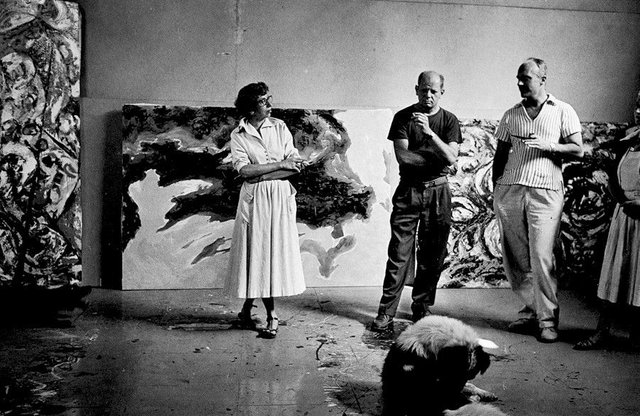
If for Europe the Second World War, rightfully, resembled the apocalypse of the twentieth century and the Judgment Day, for the American art scene, it was somehow a real refreshment. Fleeing from Nazis, many European intellectuals and artists find refuge in America, especially New York. Among them comes the tireless hunter of new talents, the famous collector and gallery owner Peggy Guggenheim.
Her New York Art Gallery will be the main stepping stone for many artists in the next eight years, including Pollock, with whom she signed the contract in 1942 for five years. That time will be enough for Peggy Guggenheim to make Pollock a real star.
His experience of painting Mural for Guggenheim's apartment was also important in spurring him on, and in 1945 he painted There Were Seven in Eight, a picture in which recognizable imagery was thoroughly suppressed and the surface was knitted together by a vivid tangle of lines. In the following years his style became more boldly abstract still, and he produced works like Shimmering Substance (1946). The following year he finally hit on the idea of flinging and pouring paint, and thus found the means to create the light, airy and apparently endless webs of color that he was reaching towards. Masterpieces such as Full Fathom Five (1947) were the result. Pollock had carried out another stylistic somersault and arrived at a method that synthesized Impressionism, Surrealism and Cubism. (1)
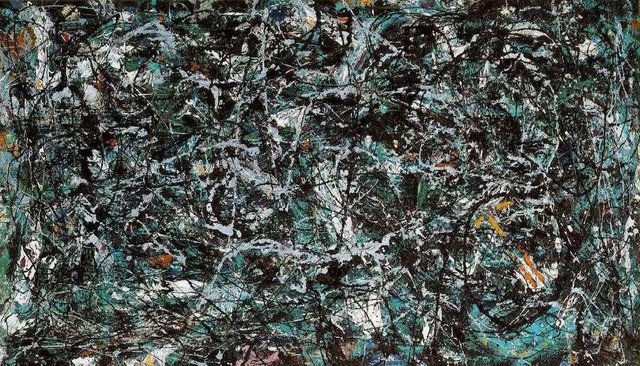
After the Venice Biennial and Exhibition, he is known and sought in Europe. Jackson Polok was named father of so-called action painting, a name introduced by American writer Harold Rosenberger in 1952, pointing out that painting became an act and action with him, "and the artist's goal is no longer to reproduce, but to enter the canvas and achieve unity between his mental state and the physical movement. " Pollock achieved this with drips, spraying techniques. By the canvas on the floor, he walked with tin boxes, from which the color was painted.
The action was important to him and the result of twisted lines that are drifting completely unconscious and directly applied to the surface of the image. "I want to express my feelings, not to illustrate them. Technique is just a means to show such a thing, " Pollock said, adding," When I'm in the picture, I'm not aware of what I'm doing. I'm not afraid to change, to "destroy" the picture, because the picture has its own life. I am trying to allow that life to come to the fore. "
By 1950, whilst his drinking increased, he returned to drawing, resurrecting some of his old motifs, and producing a series of mainly black and white poured paintings. Some, like Yellow Islands (1952), incorporate touches of color and are highly abstract; some, like Echo (Number 25, 1951), are calligraphic in style and only residually figurative; others bear clear images of heads. They were badly received when Pollock first exhibited them, but he continued to work on them right through 1953, his last productive year of work.
His personal troubles only increased in his later years. He left Betty Parsons Gallery, and, his reputation preceding him, he struggled to find another gallery. He painted little in 1954, claiming that he had nothing left to say. In the summer of 1956, Krasner took a trip to Europe to get some distance from Pollock, and soon after the painter began a relationship with 25 year old artist Ruth Kligman, who he had met at the Cedar Bar. Then, on the night of August 11, 1956, while Pollock was drunk and out driving with Kligman and her friend, Edith Metzger, he lost control of the car, killing himself and Metzger, and seriously injuring Kligman. (1)
Note: This was my translation from Serbian to English from part of the PULSE article ''Džekson Polok – otac akcionog slikarstva'' by R.Petrovic
(1)The Art story, Modern Art Insight, Jackson Pollock
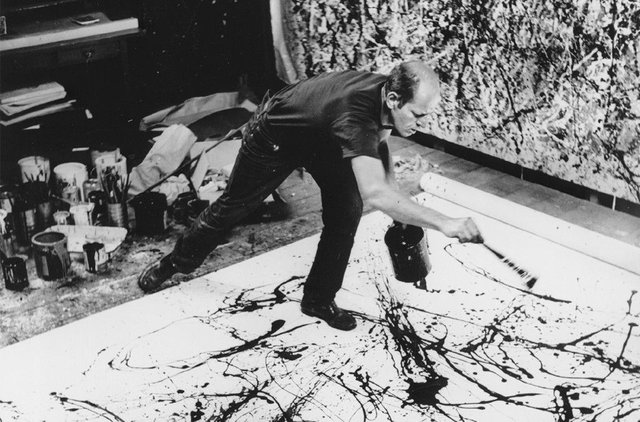
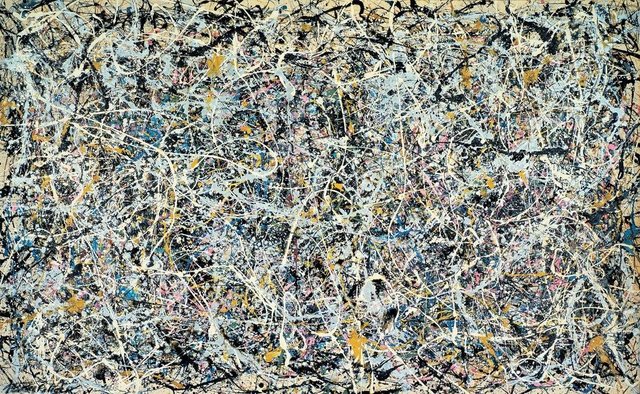
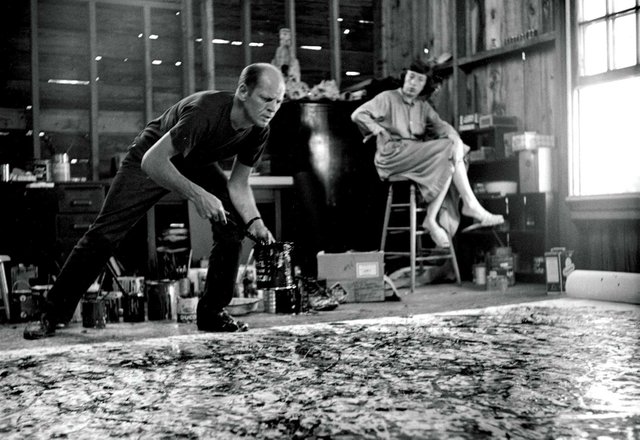
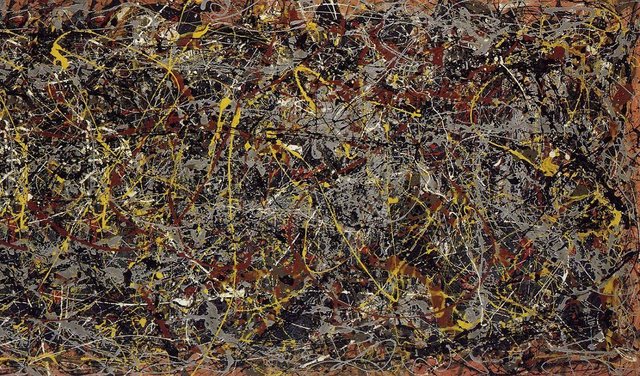
Amazing work. I have never been much of an artist other than having a bit of musical talent, but this hits home with me.
I have wanted to try making my own art with this type of method, as I feel it may be something I have success with. I think it would be a lot of fun.
Thanks for sharing, enjoy your day!
Downvoting a post can decrease pending rewards and make it less visible. Common reasons:
Submit
@memesteemit
well you never know if you never try, right? :)
Have a great day friend!
Downvoting a post can decrease pending rewards and make it less visible. Common reasons:
Submit
Wow!! You are really injurious. There is very few person have this creativity like you. Thanks @marinauzelac for sharing.
Downvoting a post can decrease pending rewards and make it less visible. Common reasons:
Submit
It is not possible to interpret the reasons why people do not understand this. Thanks for the good narration. I am trying to bring a different perspective to my work on watercolor painting.
Thank you.
Downvoting a post can decrease pending rewards and make it less visible. Common reasons:
Submit
Intresting.. I have always want to be an artist but really need what ll motivate me.. It's good to be creative, nice work friend
Downvoting a post can decrease pending rewards and make it less visible. Common reasons:
Submit
Great article about an iconic artist @marinauzelac. He's difficult artist for many to appreciate and i think your translation of this article will make it easier for some to access his vision. Lovely bit of writing.
Downvoting a post can decrease pending rewards and make it less visible. Common reasons:
Submit
thank you @adamfryda-art! :)
Downvoting a post can decrease pending rewards and make it less visible. Common reasons:
Submit
Great essay, go ahead👏🏻
resteem
Downvoting a post can decrease pending rewards and make it less visible. Common reasons:
Submit
very interesting post! thanks for sharing
let's follow each others ;)
Downvoting a post can decrease pending rewards and make it less visible. Common reasons:
Submit